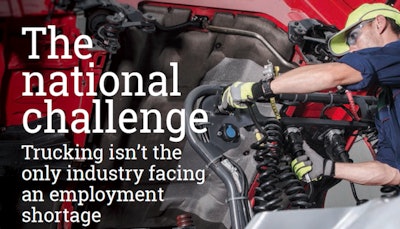

According to the Bureau of Labor Statistics (BLS), the U.S. economy recorded its 108th consecutive month of payroll gains by adding 136,000 non-farm jobs in September. These gains also helped drive the nation’s unemployment rate down to 3.5 percent, the lowest mark for the economy in 50 years. Yet as strong as these numbers appear, when coupled with the even stronger payroll gains of 2018, the BLS notes the U.S. workforce is approaching its operational peak.
There simply aren’t enough active applicants left in the market to fill all the open positions in today’s economy.
Such a competitive hiring market is doubly challenging for trucking’s service channel, which requires a higher level of education and expertise among its employees than most service sectors that hire off the street. Yet some within the market also believe the industry’s education requirement also could be turned into a positive if managed properly.
A service sector employee with no formal training and experience has little job security beyond a strong economy. However, truck technicians, once trained and skilled, are likely to be able to maintain their position and grow their career within the industry with almost no risk of job loss.
“We need to be promoting the career, that you don’t have to be a technician for 30 years. If you want to be you can, but if not, you’re going to have chances to do more,” says Tim Spurlock, co-founder and president, American Diesel Training Centers.
Adds Donald Coldwell, retail development education manager, Volvo Trucks Academy, “The most important factors in retaining newly hired technicians are quality hiring and onboarding practices, providing career development opportunities, respect and a productive work environment.”
It also is important to note a falling unemployment rate doesn’t mean there’s no one capable of working without a job.
BLS data shows 22.7 percent of un-employed workers (1.3 million people) have been out of work for 27 weeks or more. Many of these same people have since stopped looking for work because they believe no jobs are available to them. These people are among those counted in the BLS’ monthly U-6 rate, which measures the total number of unemployed workers, “plus all persons marginally attached to the labor force, plus total employed part time for economic reasons, as a percent of the civilian labor force plus all persons marginally attached to the labor force.”
BLS reports U-6 was 6.5 percent not-seasonally adjusted and 6.9 percent seasonally adjusted in September — still not a large number, but enough of a bump to give the service channel options.
To read more from Part IV of our special report, please see below:
The next steps for service: A look into the industry’s future
Click here to download the Randall-Reilly technician wage survey











